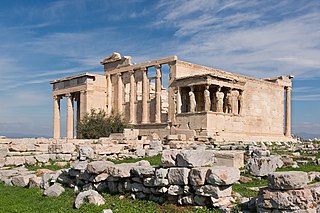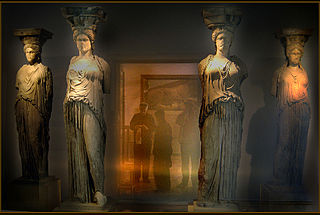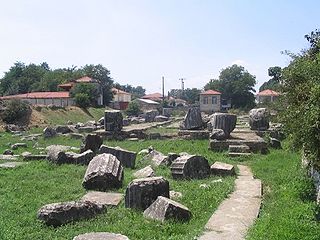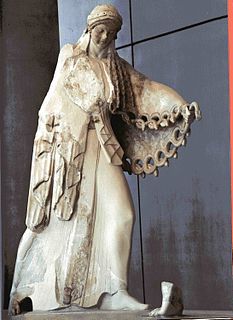
The Acropolis of Athens is an ancient citadel located on a rocky outcrop above the city of Athens and contains the remains of several ancient buildings of great architectural and historic significance, the most famous being the Parthenon. The word acropolis is from the Greek words ἄκρον and πόλις. Although the term acropolis is generic and there are many other acropoleis in Greece, the significance of the Acropolis of Athens is such that it is commonly known as "The Acropolis" without qualification. During ancient times it was known also more properly as Cecropia, after the legendary serpent-man, Cecrops, the supposed first Athenian king.
Callicrates (; Greek: Καλλικράτης, Callicrátēs) was an ancient Greek architect active in the middle of the fifth century BC. He and Ictinus were architects of the Parthenon (Plutarch, Pericles, 13). An inscription identifies him as the architect of "the Temple of Nike" in the Sanctuary of Athena Nike on the Acropolis (IG I3 35). The temple in question is either the amphiprostyle Temple of Athena Nike now visible on the site or a small-scale predecessor (naiskos) whose remains were found in the later temple's foundations. An inscription identifies Callicrates as one of the architects of the Classical circuit wall of the Acropolis (IG I3 45), and Plutarch further states (loc. cit.) that he contracted to build the Middle of three amazing walls linking Athens and Piraeus.

The Parthenon is a former temple on the Athenian Acropolis, Greece, dedicated to the goddess Athena, whom the people of Athens considered their patron. Construction began in 447 BC when the Athenian Empire was at the peak of its power. It was completed in 438 BC, although decoration of the building continued until 432 BC. It is the most important surviving building of Classical Greece, generally considered the zenith of the Doric order. Its decorative sculptures are considered some of the high points of Greek art. The Parthenon is regarded as an enduring symbol of Ancient Greece, Athenian democracy and Western civilization, and one of the world's greatest cultural monuments. To the Athenians who built it, the Parthenon and other Periclean monuments of the Acropolis were seen fundamentally as a celebration of Hellenic victory over the Persian invaders and as a thanksgiving to the gods for that victory.
Year 447 BC was a year of the pre-Julian Roman calendar. At the time, it was known as the Year of the Consulship of Macerinus and Iullus. The denomination 447 BC for this year has been used since the early medieval period, when the Anno Domini calendar era became the prevalent method in Europe for naming years.
This article concerns the period 439 BC – 430 BC.

Phidias or Pheidias was a Greek sculptor, painter, and architect. His statue of Zeus at Olympia was one of the Seven Wonders of the Ancient World. Phidias also designed the statues of the goddess Athena on the Athenian Acropolis, namely the Athena Parthenos inside the Parthenon, and the Athena Promachos, a colossal bronze which stood between it and the Propylaea, a monumental gateway that served as the entrance to the Acropolis in Athens. Phidias was the son of Charmides of Athens. The ancients believed that his masters were Hegias and Ageladas.

The Parthenon Marbles also known as the Elgin Marbles, are a collection of Classical Greek marble sculptures made under the supervision of the architect and sculptor Phidias and his assistants. They were originally part of the temple of the Parthenon and other buildings on the Acropolis of Athens.

The Erechtheion or Erechtheum is an ancient Greek temple on the north side of the Acropolis of Athens in Greece which was dedicated to both Athena and Poseidon.

Athens is one of the oldest named cities in the world, having been continuously inhabited for at least 5000 years. Situated in southern Europe, Athens became the leading city of Ancient Greece in the first millennium BC, and its cultural achievements during the 5th century BC laid the foundations of Western civilization.

A portico is a porch leading to the entrance of a building, or extended as a colonnade, with a roof structure over a walkway, supported by columns or enclosed by walls. This idea was widely used in ancient Greece and has influenced many cultures, including most Western cultures.

The Temple of Athena Nike is a temple on the Acropolis of Athens, dedicated to the goddess Athena Nike. Built around 420 BC, the temple is the earliest fully Ionic temple on the Acropolis. It has a prominent position on a steep bastion at the south west corner of the Acropolis to the right of the entrance, the Propylaea. In contrast to the Acropolis proper, a walled sanctuary entered through the Propylaea, the Victory Sanctuary was open, entered from the Propylaea's southwest wing and from a narrow stair on the north. The sheer walls of its bastion were protected on the north, west, and south by the Nike Parapet, named for its frieze of Nikai celebrating victory and sacrificing to their patroness, Athena Nike.

The Athena Promachos was a colossal bronze statue of Athena sculpted by Pheidias, which stood between the Propylaea and the Parthenon on the Acropolis of Athens. Athena was the tutelary deity of Athens and the goddess of wisdom and warriors. Pheidias also sculpted two other figures of Athena on the Acropolis, the huge gold and ivory ("chryselephantine") cult image of Athena Parthenos in the Parthenon and the Lemnian Athena.

An opisthodomos can refer to either the rear room of an ancient Greek temple or to the inner shrine, also called the adyton ; the confusion arises from the lack of agreement in ancient inscriptions. In modern scholarship, it usually refers to the rear porch of a temple. On the Athenian Acropolis especially, the opisthodomos came to be a treasury, where the revenues and precious dedications of the temple were kept. Its use in antiquity was not standardised. In part because of the ritual secrecy of such inner spaces, it is not known exactly what took place within opisthodomoi: it can safely be assumed that practice varied widely by place, date and particular temple.

The Old Acropolis Museum was an archaeological museum located in Athens, Greece on the archeological site of Acropolis. It is built in a niche at the eastern edge of the rock and most of it lies beneath the level of the hilltop, making it largely invisible. It was considered one of the major archaeological museums in Athens. Due to its limited size, the Greek government decided in the late 1980s to build a new museum. The New Acropolis Museum is now built at the foot of the Acropolis. In June 2007 the old museum closed its doors so that its antiquities could be moved to their new home, which opened on 20 June 2009.

The Older Parthenon or Pre‐Parthenon, as it is frequently referred to, constitutes the first endeavour to build a sanctuary for Athena Parthenos on the site of the present Parthenon on the Acropolis of Athens. It was begun shortly after the battle of Marathon upon a massive limestone foundation that extended and leveled the southern part of the Acropolis summit. This building replaced a hekatompedon and would have stood beside the archaic temple dedicated to Athena Polias.

The city of Athens during the classical period of Ancient Greece was the major urban center of the notable polis (city-state) of the same name, located in Attica, Greece, leading the Delian League in the Peloponnesian War against Sparta and the Peloponnesian League. Athenian democracy was established in 508 BC under Cleisthenes following the tyranny of Isagoras. This system remained remarkably stable, and with a few brief interruptions remained in place for 180 years, until 322 BC. The peak of Athenian hegemony was achieved in the 440s to 430s BC, known as the Age of Pericles.

The Hekatompedon or Hekatompedos, also known as Ur-Parthenon and H–Architektur, was an ancient Greek temple on the Acropolis of Athens built from limestone in the Archaic period, and was placed in the position of the present Parthenon.
The festival calendar of Classical Athens involved the staging of many festivals each year.

The Achaemenid destruction of Athens was accomplished by the Achaemenid Army of Xerxes I during the Second Persian invasion of Greece, and occurred in two phases over a period of two years, in 480-479 BCE.


















